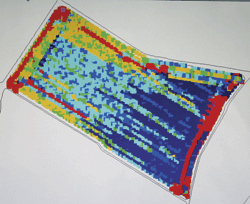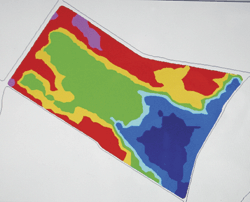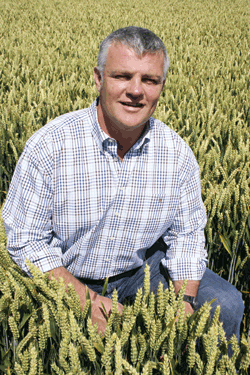Variable rate seed application works in Nottinghamshire

If different soils have different potential to get a crop going and support its early growth, why use a blanket seed rate? That was the rhetorical question Peter White answered for himself four years ago when the purchase of a new drill gave him the opportunity to use different seed rates within fields, not just from field to field.
“It’s something I’d wanted to do for a while and in some fields, where soils were different on one side of a field to the other, we did adjust the rate accordingly,” he says. “But with some fields containing up to five variations of our Keuper Marl silty clay loam, GPS technology was the only way we could do it with any precision.”
This autumn, as in the past four, fields will be sown with as many as five different rates, typically ranging from 90% to 125% of the “base” rate and, on the best soils in perfect conditions, down to 85% of that figure.
“The objective isn’t to save money by using less seed; we’re still using about the same in total,” Mr White explains. “But we’d always struggled to get even plant counts and when I saw satellite plant density images that closely matched some familiar soil type patterns on the farm, I felt precision seed rate adjustment was the way to go.”



Leyfields extends to 800ha (1975 acres) at Kneesall near Newark. This year, winter oilseed rape and first wheats accounted for about 70% of the arable area in roughly equal proportions, with the rest down to second wheats and 100ha (250 acres) of spring malting barley – a newcomer to the rotation on the lighter land to help tackle blackgrass and spread the workload.
Five-year average yields are running at 10.13t/ha (4.1t/acre) for wheat – with 2008 results coming in a bit better than that – and oilseed rape at 3.6t/ha (1.45t/acre).
A devotion to minimum tillage managed with the help of a spade and penetrometer has brought clear improvements in soil structure and general well-being so all straw is chopped on the combine and stubble tackled by Simba and Horsch cultivators that prepare the way for a Sprinter ST tine drill.
This arrived on the farm in 2005 complete with electric drive to the Horsch seed metering system and a GPS package from Farm Works comprising a hand-held PDA with GPS receiver and Track Mate, Site Mate and Guide Mate software, plus the Farm Track and Farm Site laptop computer software.
The first challenge was to create the seed rate maps: “I’m fortunate in having a good knowledge of the soil type distribution having farmed here for more than 20 years; it would be more difficult on unfamiliar ground,” says Mr White. “We’re also fortunate in having soils that are quite distinct.”
For some fields, it was a case of simply sitting down with the laptop and drawing the different soil zones; in others, running around on a quad bike using the PDA as a GPS plotter provided the application map.
But the most effective method, it seems, has been to put on-the-go rate adjustment in the capable hands of drill operator Adam Swan, record his inputs and, after a bit of tweaking and smoothing here and there, use that data for the following year’s seed rate map.

“Sitting high on the tractor gives you a good perspective; differences in colour and physical characteristics show the boundaries between one soil type and another very clearly on freshly cultivated soil,” he says. “And, of course, you’re covering the whole field. It brings a lot more precision to the broad-brush approach you get from using your own knowledge of fields or walking them at ground level.”
A typical rate of 170 seeds/sq m for sowing in the third week of September are shifted upwards on heavier, poorer soils to compensate for likely germination and drainage issues, and in anticipation of a higher slug population.
“The higher rate also offsets the tendency for these soils to be colder and slower to warm up in spring, resulting in plants that don’t tiller as well,” Mr White explains. “We’ll trim the rate on better and more fertile soils where we expect a higher germination percentage and better tillering – and to avoid lodging, because that’s the last thing we want with a minimum tillage system.”
Rates may be adjusted season-to-season to some extent, based on how fields performed the previous year, but he warns against making frequent changes that may confuse the interpretation of crop performance.
“If you’ve a good reason to expect a heavier slug burden in a particular field or you’ve had lodging in some areas, then fine,” he says. “But I think you’ve got to be wary of constantly making changes when you don’t know what the season ahead is going to bring.”
One limitation of the current set-up is that once the data has been recorded to an SD card and that has been slotted into the drill’s control box there is no opportunity to make further tweaks – to compensate on the day for a cobbly seed-bed, for example. That would only be possible if the in-cab control unit could run the mapping software.
Precision farming sceptics will also point out that it is something of an act of faith to accept that what the drill terminal says is being sown is what is actually being sown. In this case, reassurance comes from the Farm Works software totting up the total amount of seed required to sow each field in often quite complex seed rate patterns.
The next step will be to use yields maps to further analyse the causes of variations in crop performance across individual fields. Results from the difficult 2007 harvest are being disregarded, so it is hoped that yield contour maps from this year’s campaign can be looked at alongside those from last year to start picking out areas for investigation.
While Mr White is excited by the rewards of precision farming technology he readily admits to being ‘pretty clueless’ when it comes to the software technicalities. But Adam Swan has taken to it with enthusiasm – preparing and manipulating the maps and sowing crops at variable seed rates has added a new dimension to his job and one that he enjoys.
Nor does it take up an inordinate amount of management time, as some sceptics fear precision farming technology is bound to do: “It’s a good way to make productive use of wet days,” says Mr White.

